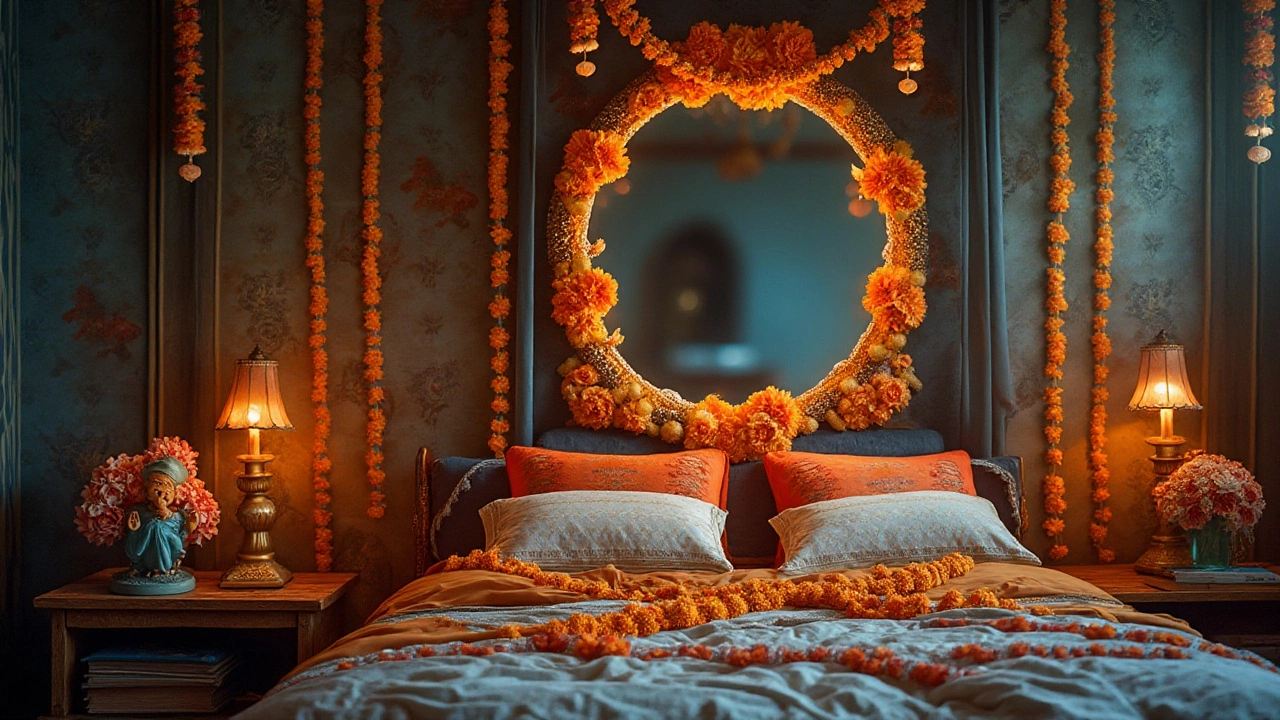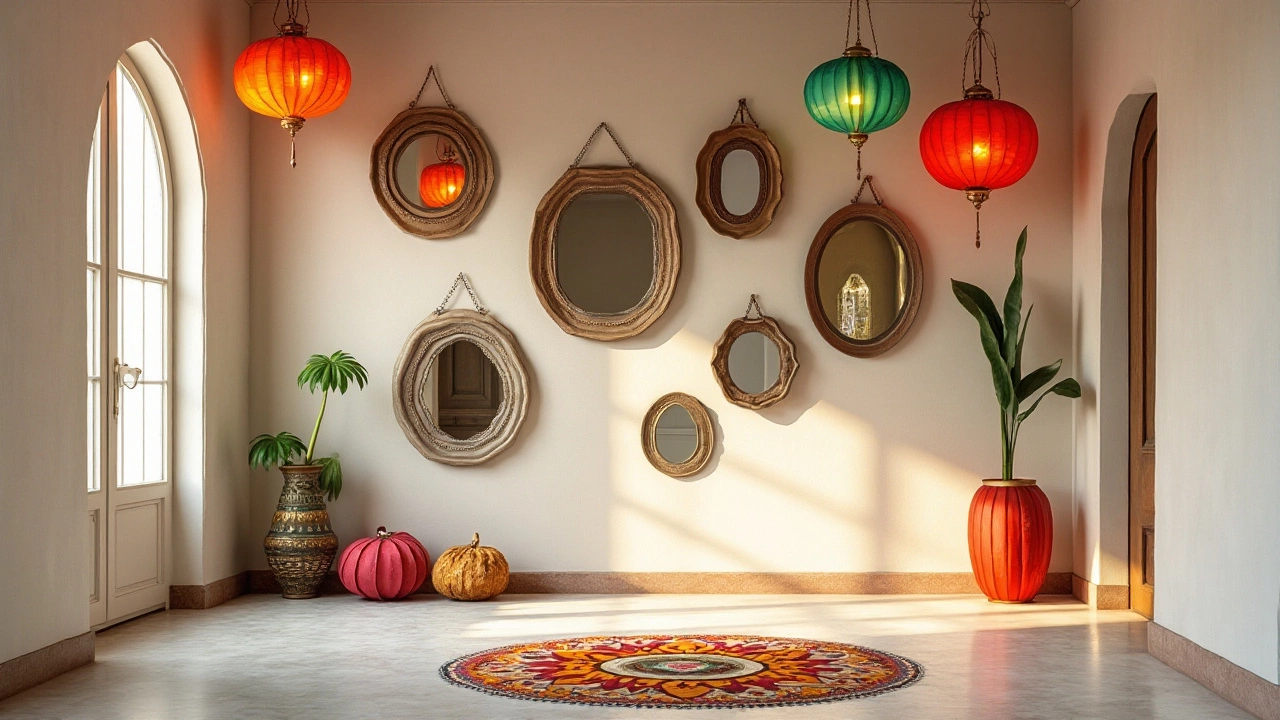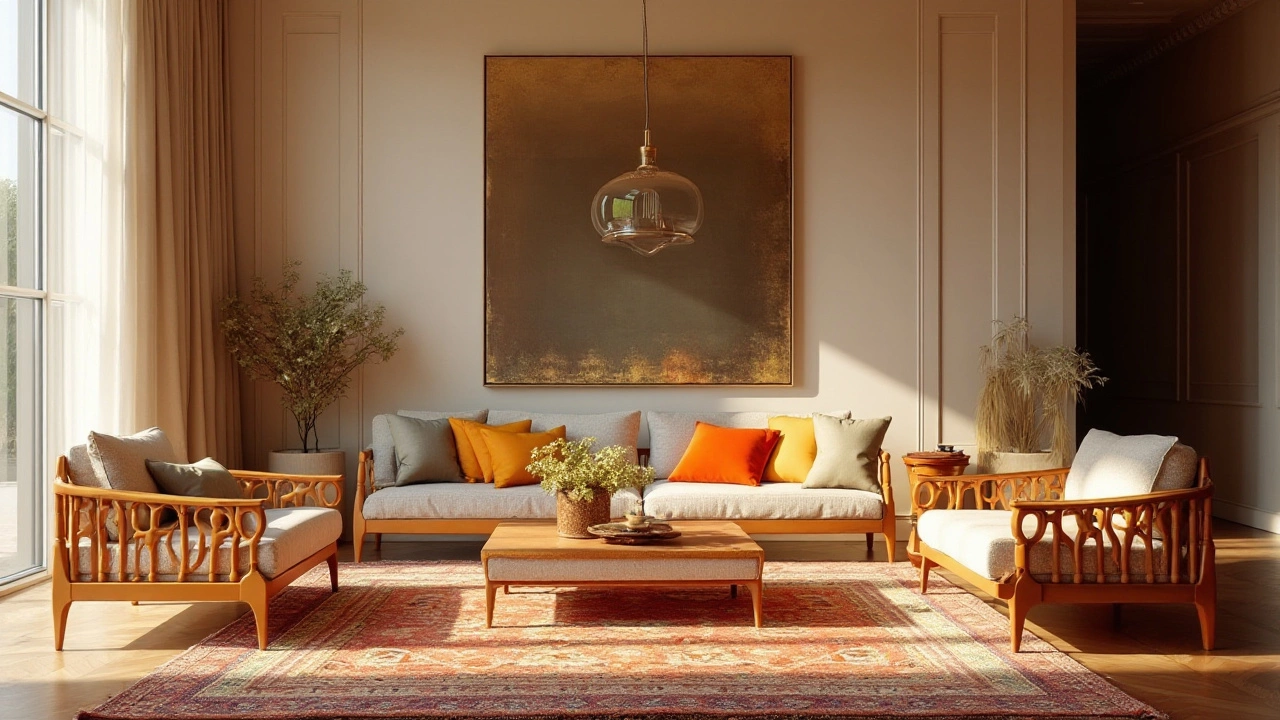Mirrors do more than reflect our image; they bring light, depth, and style into our homes. Their shape can influence the mood and aesthetics of a room. When choosing a mirror, considering its shape is as important as its size and placement.
Rectangular mirrors have long been staples in homes, celebrated for their adaptability and timeless appeal. They fit seamlessly in both modern and traditional interiors, making them easy favorites for many. However, round mirrors are stepping into the limelight, loved for their ability to soften spaces and add an air of refinement.
Exploring outside the box, unconventional mirror shapes spark intrigue and conversation. Mirrors in abstract forms can be fantastic focal points, showcasing your unique taste. But how do we decide which shape suits which room? This guide offers practical advice for making that choice.
- Understanding Mirror Shapes and Styles
- Rectangular Mirrors: Classic and Versatile
- Round Mirrors: Soothing and Elegant
- Unconventional Shapes: Uniqueness and Creativity
- Choosing the Right Shape for Each Room
Understanding Mirror Shapes and Styles
Mirrors are often thought of as mere functional objects found in bathrooms or dressing rooms, but they hold a much deeper significance within the realm of interior design. Each mirror shape carries its own essence and has the power to influence the energy and style of a space. Imagine walking into a room and being greeted by a beautifully arched mirror shape, or a geometric design that draws your eye across the wall. The shape of a mirror can make an ordinary wall seem suddenly alive with creativity and charm. Selecting the right shape can enhance other design elements in surprising and delightful ways.
The symmetry and linear appeal of rectangular mirrors often aligns with a sense of order and control in a room. This classic shape harmonizes wonderfully with various styles, from minimalistic to classic, and can elongate a room, making narrow spaces like hallways feel grander than they are. Meanwhile, curving round mirrors offer a distinct softness that is especially soothing, serving as a natural counterbalance to the hard edges of furniture and architectural lines. A round mirror is also a delightful choice over a bedroom dresser or to anchor a feature wall in a dining area, transforming the atmosphere with elegance.
Interestingly, a growing trend in home design is the play with bolder and more ornate mirror forms. Unique and irregularly shaped mirrors can express one's personal style, introducing an element of artistry into the home environment. These unconventional shapes often grab attention, breaking the monotony of rectangular and circular shapes and creating focal points that make a statement. A space can be redefined by adding a mirror that embodies whimsical or abstract forms, capturing not only reflections but also the imagination of anyone who gazes upon it.
For those still pondering the significance of these choices, consider the insightful words of renowned interior designer, Sarah Richardson:
"A mirror reflects the soul of a space, and its shape is the framework that defines that reflection."This idea underscores the influential nature of a mirror's silhouette, shaping not just reflections but also the overall ambiance and personality of a room.
It’s also worth noting that experimentation with mirror shapes isn't constrained to wall mirrors. Freestanding mirrors offer another layer of versatility, with some featuring abstract constructions that can transform an entire space. Both practicality and aesthetics go hand-in-hand; a well-chosen mirror can magnify light, highlight architectural features, or add visual interest to an otherwise plain wall. When deciding which mirror style suits your home, think about the design narrative you wish to tell. Whether it whispers of sophisticated elegance or speaks boldly of modern artistry, the right mirror shape can make the narrative of your space feel well-rounded and complete.
Rectangular Mirrors: Classic and Versatile
When it comes to interior design, the rectangular mirror stands as a quintessential element, cherished for its timeless style and unparalleled versatility. This shape, defined by its straight lines and angular form, has a way of naturally fitting into a variety of room designs, from the ultra-modern to the classically traditional. The popularity of rectangular mirrors is no accident; their ability to enhance a space visually has been observed throughout the ages.
Historically, these mirrors have graced grand ballrooms and modest living rooms alike, providing not only function but a touch of sophistication. For those looking to enhance the dimension of a room, rectangular mirrors can work wonders. By strategically placing a rectangular mirror opposite a window, natural light can be amplified, making a small room feel much larger and brighter. This trick is not just hearsay; a study in 2018 highlighted that bouncing light around a room with mirrors could reduce the need for artificial lighting by up to 30%. It doesn't merely boil down to aesthetics; there are practical benefits as well.
According to acclaimed interior designer Kelly Hoppen, "Rectangular mirrors are my go-to when I need to add elegance and structure. They ground a room in a way no other shape can."
One of the advantages of choosing a rectangular mirror is its ability to align with the surrounding architecture. This shape can echo the lines of windows, furniture, and even flooring, creating a harmonious visual narrative. Designers often employ this shape above mantels and in entryways where balance can be achieved effortlessly. The mirror's edges also provide a clean, meticulous finish that enhances minimalist spaces without overwhelming them.
When considering the placement of a rectangular mirror, height is a factor to be mindful of. Hanging a mirror at eye level is standard, but slight adjustments can alter a room's perception. For instance, placing a mirror higher can create the illusion of a taller ceiling, while aligning it lower might make the space feel cozier and grounded. An easy guideline to follow is to hang it around 57 to 60 inches from the floor, but do remember this can flex depending on the particular characteristics of the wall or the other elements in the room.
A well-known benefit of rectangular mirrors is their ability to act as silent communicators of style. An embellished, ornate frame can add a touch of luxury, while a simple, frameless design might emphasize a modern aesthetic. It's a shape that fits into the gallery of any art aficionado without stealing the limelight from other cherished pieces. The frame style you choose can transform the entire vibe of the mirror, aligning it with your personalized vision.
For those interested in statistics, surveys have shown that 60% of homeowners prefer rectangular mirrors in their bathrooms due to their expansive reflection area. The reason this style is favored particularly in grooming areas is that it provides a full, unobstructed view, making morning routines more efficient and enjoyable.

Round Mirrors: Soothing and Elegant
There's something inherently calming about the shape of a circle, which might explain why round mirrors are often described as soothing and elegant. The continuous, unbroken line of a circular mirror offers a sense of completeness and harmony that few other shapes can match. This quality makes round mirrors particularly effective in spaces where tranquility is desired, such as bedrooms and bathrooms. Their ability to soften angular room features further enhances this calming effect, creating a visual balance that is pleasing to the eye. Round mirrors also have the fascinating ability to serve as both a decorative piece and a functional item, reflecting light in ways that open up spaces and make them feel more inviting.
In terms of home decor, round mirrors can act as a striking focal point in any room, drawing attention without overwhelming the space. Their versatility means they can be styled in various ways to complement different interior aesthetics. For example, a round mirror with a minimalist frame can enhance a contemporary living room, while an ornate circular mirror might suit a more traditional setting. From small bathrooms desiring an elegant touch to larger dining areas that benefit from a statement piece, the style possibilities are endless with round mirrors. According to decorator Mary McDonald noted in an interview with Architectural Digest, "A round mirror can reflect not only the beauty of light and the room but also our innate desire for connection and wholeness."
Round mirrors also cater to specific functional needs, such as enhancing natural light. In rooms with limited sunlight, strategically positioning a round mirror opposite a window can amplify the light's reach, creating an illusion of brightness and space that enlivens even the dimmest settings. This technique is particularly effective in small rooms or narrow hallways where light is scant. Space perception, enhanced by the curvature of round mirrors, delivers a sense of movement and flow, welcoming an effortless transition between areas within a home.
When considering round mirrors, it's essential to think about size and placement. A petite round mirror can add charm above a vanity or in a gallery wall arrangement, whereas a larger piece can command attention, creating a statement in an entryway or over a mantelpiece. Properly placing a round mirror at eye level will not only enhance its functionality but also ensure that it flows seamlessly with the furniture and decor surrounding it. Believe it or not, the shape of a mirror can influence energy dynamics in a room. According to principles of Feng Shui, round mirrors contribute to positive energy flow, reinforcing peace and well-being throughout the space.
Unconventional Shapes: Uniqueness and Creativity
In the world of home decor, pushing boundaries often leads to the most stunning transformations. When it comes to mirrors, opting for unconventional shapes can be a bold yet rewarding choice. These mirrors defy the typical rectangle or circle, offering designs that capture attention and spark imagination. Such pieces are not just functional; they are works of art that convey personality, intrigue, and a sense of adventure. Mirrors crafted in the form of stars, hexagons, or even irregular organic shapes can become the centerpiece of any room, turning empty walls into expressive canvases. Choosing a unique mirror shape can dramatically alter the feel of an interior, allowing homeowners to weave their tastes delicately into the space. This practice can rebut the monotony that often accompanies standard decor choices.
Unconventional mirrors provide an opportunity to explore your individuality within your living environment. Unlike mainstream options that comply with traditional aesthetics, these shapes invite creativity. The abstract and avant-garde essence of such mirrors often align with artistic or eclectic decor styles. However, their versatility should not be underestimated. Even in minimalist or rustic environments, a distinct mirror can establish a captivating contrast that enrichens the ambiance. Notably, unconventional mirrors can also serve different functional purposes. For instance, a triangular mirror strategically placed can reflect light differently, potentially altering the room's illumination to fit certain moods. Interior designers often embrace these pieces to disrupt predictability and introduce uniqueness that engages more deeply with the viewer.
The benefits aren't just visual; they can be emotional too. Having a distinct mirror shape can invoke curiosity and prompt conversations—something Gareth always appreciates during our lovely evening gatherings. It’s intriguing how such a simple object can become a potent symbol of one’s lifestyle philosophy. Furthermore, unconventional mirrors allow us to break free from the constraints of symmetry and predictability. The freedom to choose exciting shapes contributes to the sense of authenticity that many seek in their homes.
"Your home should tell the story of who you are, and be a collection of what you love," reflects Nate Berkus, renowned interior designer.With these distinctive choices, we can narrate more dynamic and personal stories within our spaces. Ultimately, picking unusual mirror designs ignites dialogue between homeowners and their spaces, solidifying mirrors not merely as functional items but as storytellers and symbols of self-expression.

Choosing the Right Shape for Each Room
When it comes to selecting the perfect mirror shape for distinct spaces, context is key. Each room in a home serves a unique function and conveys its own atmosphere, which can be amplified by the right mirror. In living rooms, for instance, mirrors not only embellish the walls but also play a pivotal role in magnifying light and creating the illusion of more space. A sizable rectangular mirror above the fireplace can introduce balance and frame the setting perfectly. Such mirrors not only complement traditional décors but blend beautifully with contemporary themes as well, all while spotlighting focal elements of the room such as artwork and seating arrangements.
The dining room, on the other hand, might benefit from the introduction of a round mirror. Round mirrors exude elegance, often adding a sense of harmony and unity to spaces used for gatherings and meals. Their sociable shape encourages relaxation and imparts a friendly, welcoming vibe. Placed opposite to a window, they can further enhance the natural light, making meals feel more refreshing and rejuvenating. In smaller rooms or hallways, a round mirror can serve almost like a jewelry piece, adding sparkle and interest without being overpowering.
Lacey Jane, an interior design expert, once said, "A mirror flips the room back upon itself in the most elegant manner, whether you're opting for the bold angles of a rectangle or the calm serenity of a circle."
Bathrooms are a realm of their own when it comes to mirror style. Here, it's essential to match the mirror's shape with the vanity and the amount of wall space available. Rectangular mirrors often work best for double vanities, offering extensive reflection space, whereas circular mirrors harmonize with oval sinks and add a spa-like ambiance. For the adventurous at heart, an unconventional shape, like an oval or irregular form, can add a unique touch that turns an ordinary bathroom into a personal retreat, sparking conversation and joy in what would traditionally be a functional space.
Meanwhile, in bedrooms, the mirror's shape should contribute to an air of tranquility and intimacy. Full-length mirrors remain an essential, providing functionality for dressing while enhancing the perceived room size. These mirrors, in either a rectangular or oval shape, can have a profound impact on room aesthetics, often becoming cherished pieces of decor. Yet, adding smaller round mirrors above a dresser can create a whimsical focal point, encouraging restfulness and relaxation. A layered look can be achieved by combining different shapes, lending an air of casual charm while keeping the space engaging.
When it comes to home offices, the mirror's shape and style should support concentration and clarity. A neat and crisp rectangular mirror positioned strategically ensures that the space doesn’t feel cramped and allows for flow. Large rectangular mirrors can also serve as an extra window, making dark offices feel open and well-ventilated. To inject creativity into a more sterile or rigid space, consider adding a mirror shape that introduces interest and even a bit of whimsy, such as geometric designs that echo creativity and modernity.
Ultimately, marrying the shape of a mirror with the intended vibe and function of a room provides limitless opportunities to fashion remarkable interiors. Mirrors are, after all, storytellers of space, reflecting not just physical appearances but the moods a room strives to achieve and the personalities that inhabit them.
